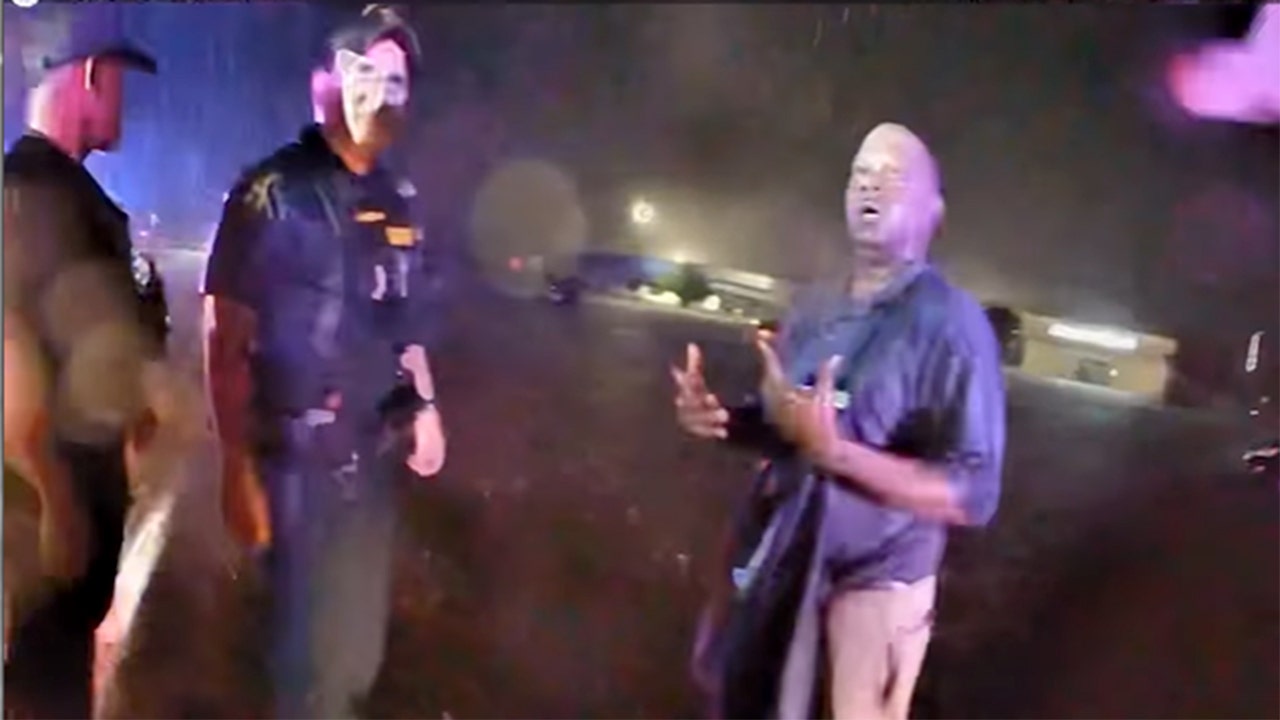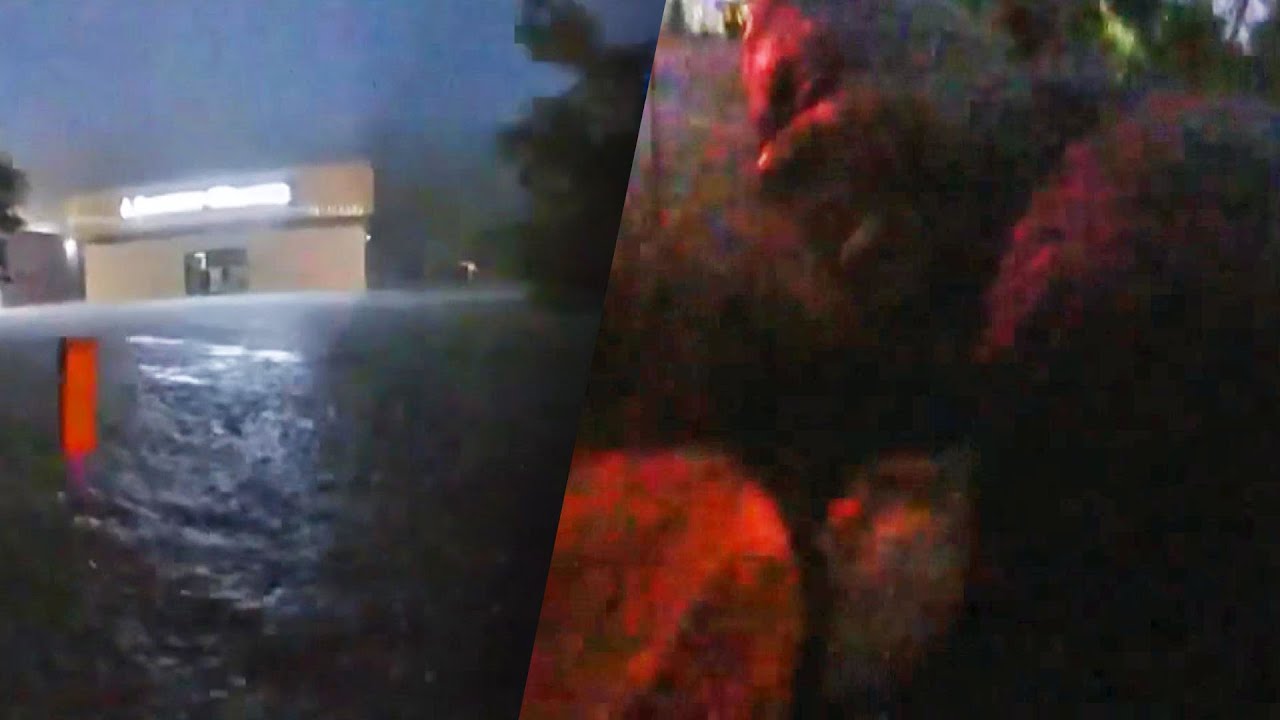Florida Officer And Man Sucked Into Drain Pipe During Flood Rescue
Escambia County, Florida - In a heart-stopping incident that unfolded on Friday morning, an astonishing display of bravery was captured on body camera footage as a Florida officer and man sucked into drain pipe during a flood rescue.
Author:Morgan MaverickReviewer:Professor JhizJun 21, 2023855 Shares171K Views

Escambia County, Florida - In a heart-stopping incident that unfolded on Friday morning, an astonishing display of bravery was captured on body camera footage as a Florida officer and man sucked into drain pipeduring a flood rescue.
Florida Deputy William Hollingsworth risked his life to save a man trapped in floodwaters. The harrowing rescue took place amidst the severe weather conditions that have been ravaging Escambia County, leaving the community in distress.
Florida Officer And Man Sucked Into Drain Pipe
According to the Escambia County Sheriff's Office, Deputy Hollingsworth was on patrol duty, assisting stranded motorists who found themselves caught in the rapidly rising waters. As he ventured into the treacherous conditions, he noticed a citizen in desperate need of help and immediately rushed to their aid, displaying incredible selflessness that goes beyond the call of duty.
However, as the deputy approached, the situation took a turn for the worse. The citizen, already trapped in the floodwaters, was suddenly submerged underwater, prompting Deputy Hollingsworth to act swiftly and without hesitation. Ignoring his own safety, he dove into the water, determined to rescue the imperiled individual.
Tragically, both the citizen and Deputy Hollingsworth were pulled into a nearby drainage pipe by the force of the rushing water. The shocking turn of events was captured by the body camera, showcasing the perilous struggle they faced as they were swept nearly 100 feet underwater. For an agonizing 30 seconds, the footage reveals their struggle against the current and the darkness that engulfed them.
However, fate smiled upon them, and they emerged on the other side of the highway, gasping for breath and grateful to have survived such a terrifying ordeal.

Officer and Citizen Sucked into Drainage Pipe
The video captures Deputy Hollingsworth's immediate concern for the distressed individual, as he rushes to his side, checking if he is okay and offering reassurance.
“„You okay, buddy? Can you believe what just happened to us?- Florida Deputy William Hollingsworth
Overwhelmed with shock, the citizen exclaims, "I almost died," a testament to the gravity of the situation they both narrowly escaped.
Following the rescue, Hollingsworth ensured the man's safety by bringing him to a secure location and promptly alerted other officers for assistance. The grateful citizen expressed his deep gratitude to the deputy for his life-saving efforts, acknowledging the incredible timing that saved them both from a potentially tragic end.
The Escambia County Sheriff's Office commended Deputy Hollingsworth's extraordinary courage, highlighting the video footage as an example of the exceptional bravery displayed by law enforcement personnel every day. The gripping video quickly spread across social media platforms, attracting a flood of praise and admiration for the deputy's selflessness.
Social media users lauded Deputy Hollingsworth for his heroic act, commending his unwavering courage and dedication to protecting and serving the community. Messages of support and appreciation poured in, with one user stating:
“„This is an outstanding show of courage.- Message of Support from a User
Another emphasized the importance of his actions, writing:
“„From one law enforcement officer to another; you are the example of what protect and serve means... I salute you.- Message of Support from a User
The footage serves as a powerful reminder of the risks that law enforcement officers face daily in the line of duty and their unwavering commitment to preserving the safety and well-being of their communities. Deputy Hollingsworth's selfless actions will undoubtedly inspire others and stand as a shining example of the bravery that resides within those who choose to serve and protect.
As the floodwaters continue to wreak havoc in Escambia County, the heroic rescue serves as a beacon of hope, reminding residents that in the face of adversity, there are dedicated individuals like Deputy William Hollingsworth who are willing to risk their lives to save others.
The Role Of First Responders In Emergency Preparedness And Response
When emergencies or disasters strike, first responders are the unsung heroes who rush to the scene, providing critical services and support. In areas, where resources may be limited, the role of first responders becomes even more vital.

The Anatomy and Physiology of First Responders
Let's look into the indispensable role of first responders in rural emergency preparedness and response efforts, highlighting the unique challenges they face and the importance of their training, staffing, and preparedness.
Planning For First Responder Needs
During the planning phase of emergency management, it is crucial to consider and address the specific needs of first responders. This includes ensuring they receive appropriate training, have adequate staffing and volunteer support, and are well-prepared for their roles.
Training - Equipping First Responders for Success
Identifying the different groups of first responders and ensuring they receive comprehensive and ongoing training is paramount. This involves providing formal training programs, certifications, and familiarization with emergency response protocols and communication processes. Each group of first responders should receive training that aligns with their specific roles and responsibilities.
Training Considerations for First Responders:
| Considerations | Examples |
| Formal training programs and certifications | Basic life support (BLS), cardiopulmonary resuscitation (CPR) |
| Familiarity with emergency response protocols | Incident command system (ICS), triage procedures |
| Communication processes and specific responsibilities | Radio communication, incident reporting |
Staffing and Volunteers - Mobilizing Community Support
In rural communities, where resources may be scarce, volunteerism often plays a significant role in emergency response. Many community members step up to become volunteer first responders, supplementing the efforts of professional responders. These dedicated individuals may require additional training and support, considering that emergency response is not their primary occupation.
Staffing and Volunteer Considerations:
| Considerations | Examples |
| Recruitment and training of community volunteers | Community emergency response team (CERT) programs |
| Partnerships with local organizations | Collaboration with schools, faith-based groups |
| Filling staffing gaps through collaborative efforts | Retired first responders, partnerships with industry |
First Responder Preparedness
First responders must not only be prepared to assist others during emergencies but also ensure their own well-being and readiness. Personal preparedness is essential to minimize stress and enhance their effectiveness during response operations.
Here are key steps that individual first responders can take:
- Build an emergency supply kit - Having a well-stocked emergency supply kit is vital for first responders. This kit should include essential items such as water, non-perishable food, medical supplies, and personal protective equipment (PPE).
- Make a family emergency plan- First responders should create a comprehensive emergency plan for their families. This plan should outline communication strategies, evacuation routes, and contingency arrangements for child and eldercare.
- Stay informed and educated - First responders need to stay updated on the types of emergencies they may encounter in their community. They should be aware of the latest protocols, procedures, and protective actions to take during various emergency scenarios.
- Prioritize mental and emotional well-being- The nature of first responders' work exposes them to high-stress situations and traumatic experiences. It is crucial for them to prioritize their mental and emotional well-being. Support networks, peer counseling programs, and access to mental health resources are essential components of first responder preparedness.
Response - Ensuring First Responder Safety And Effectiveness
During the response phase of emergency management, the safety of first responders takes center stage. Attention should be given to communication processes, mental health support, access to protective equipment, and ensuring overall well-being.
Communication and Coordination
Effective communication and coordination are paramount to ensure the safety of first responders. They should have up-to-date contact lists, including supervisors, response partners, and fellow first responders. Reliable communication methods, such as radios, cellphones, or other reliable technologies, should be in place. Contingency plans for situations where communication may be compromised should also be developed.
Adaptation and Resilience
First responders must be prepared to adapt to changing circumstances and increased workloads during response operations. For instance, the COVID-19 pandemic has required adjustments to standard operating procedures.
Fire departments have reassigned personnel, volunteers have been recruited to meet increased demand for emergency medical services, and protocols for decontamination and PPE usage have been implemented. Resilience, camaraderie among responders, good leadership, and social support are critical for effective response and the well-being of first responders.
Recovery - Supporting First Responders' Mental Health
Following an emergency or disaster, the recovery phase is a critical time to address the mental health needs of first responders. The stress and emotional toll of their work make them particularly vulnerable during this phase.
Recognizing Mental Health Challenges
Studies have shown that first responders are at increased risk of developing behavioral health conditions, including depression, post-traumatic stress disorder (PTSD), substance use disorders, and suicidal ideation. Recognizing these challenges and addressing them proactively is crucial.
Promoting Resilience and Well-Being
Supporting first responders' mental health requires a multifaceted approach. This includes providing access to professional mental healthcare services, promoting peer support networks, and implementing stress reduction programs. It is also important to address risk factors such as excessive exposure to media coverage of disasters and inadequate support and appreciation for their efforts.
First responders are the backbone of emergency preparedness and response efforts in rural communities. Their dedication, training, and commitment to service play a critical role in saving lives and supporting communities during times of crisis.
Recognizing and addressing the specific needs of first responders in planning, training, staffing, and preparedness is essential for their effectiveness and well-being. Supporting their mental health throughout all phases of emergency management ensures their continued ability to serve and protect their communities.
People Also Ask
What Is The Role Of The Emergency Responder?
The role of emergency responders includes conducting risk assessments, providing urgent healthcare services, contributing to emergency planning, and maintaining public awareness and communication regarding health issues.
What Is The Role Of The First Responder?
The role of a first responder is that of a highly trained individual who arrives at the scene of an emergency, such as an accident, disaster, or medical incident, to provide immediate assistance and resolution. They are among the initial responders who offer critical support in various situations, including structure fires, crimes, and terrorist attacks.
What Are The 5 Roles In Emergency Response And What Are Their Responsibilities?
Emergency Management comprises five key steps: prevention, mitigation, preparedness, response, and recovery. These steps encompass activities to avoid incidents, minimize impact, ensure readiness, address emergencies, and facilitate long-term recovery.
What Is Emergency Preparedness And Response?
Emergency preparedness and response involves the planning, coordination, and protection measures implemented to effectively handle chemical, biological, radiological, and natural disasters. This program focuses on integrating occupational safety and health considerations to safeguard the well-being of response and recovery workers.
Who Is The Person Responsible For All Aspects Of An Emergency Response?
The fire chief assumes overall responsibility for every aspect of an emergency response. They hold the operational management authority for the response effort, overseeing all activities within the disaster area. As a vital member of the disaster management team, the fire chief translates the team's decisions into practical actions on the ground.
Conclusion
In conclusion, the role of first responders in rural emergency preparedness and response cannot be overstated. These dedicated individuals, including the Florida officer and man sucked into drain pipe, put their lives on the line to serve and protect their communities.
From planning and training to response and recovery, first responders play a crucial role in ensuring the safety and well-being of individuals during times of crisis. Their training, preparedness, and resilience are essential in mitigating the impacts of emergencies and disasters.
It is imperative that we recognize and address their specific needs, including mental health support, staffing, and volunteer considerations. By supporting first responders and prioritizing their well-being, we can ensure their continued ability to bravely and selflessly navigate the challenging and unpredictable situations they encounter.
The incredible bravery and determination displayed by first responders like the Florida officer serve as a reminder of their unwavering commitment to serving the public and saving lives, even in the face of extraordinary circumstances.

Morgan Maverick
Author
Morgan Maverick is an unorthodox news reporter driven by an insatiable hunger for the truth. Fearless and unconventional, he uncovers hidden narratives that lie beneath the surface, transforming each news piece into a masterpiece of gritty authenticity. With a dedication that goes beyond the boundaries of conventional journalism, Morgan fearlessly explores the fringes of society, giving voice to the marginalized and shedding light on the darkest corners.
His raw and unfiltered reporting style challenges established norms, capturing the essence of humanity in its rawest form. Morgan Maverick stands as a beacon of truth, fearlessly pushing boundaries and inspiring others to question, dig deeper, and recognize the transformative power of journalism.

Professor Jhiz
Reviewer
Professor Jhiz brings fun to teaching anatomy. Born in China, she shares her fascination for how the body works.
Students say her lectures are lively with jokes and stories. She draws cartoon diagrams that highlight structures creatively.
Professor seeks to inspire curiosity and joy in anatomy. She treats each class like a show using props and costumes.
When not teaching, Jhiz enjoys karaoke and novelty socks. Her goal is passing on a spirit of wonder to students.
Latest Articles
Popular Articles

